White Wyandotte: Breed Profile
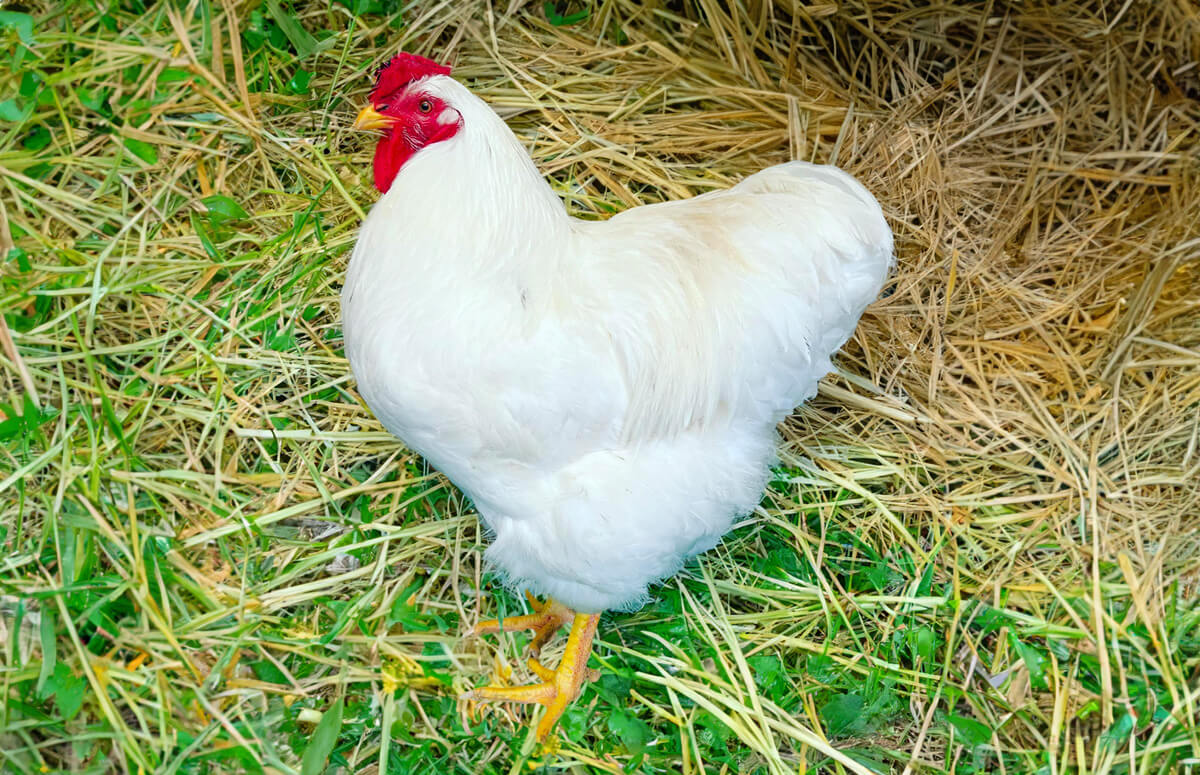
Characteristics | Eggs | Pros & Cons | Hen vs Rooster | Chicks | Care | Climate | White Color Pattern | History | Genetics | Breeding | Personality
Among the rustic charm of your chicken coop, one breed will steal the show with its snow-white feathers glowing in the morning light. That’s the White Wyandotte chicken – a breed combining beauty and utility.
We’ll take you on a journey into the world of the White Wyandotte.
| Eggs | 200 eggs/year |
| Egg Color | Brown |
| Egg Size | Large |
| Weight | 6.5 – 8 lbs |
| Hardiness | Cold |
| Temperament | Friendly but assertive |
| Beginner-friendly | Yes |
| Color | White |
Characteristics
As the name implies, the most noticeable feature of the White Wyandotte is its snow-white plumage. This immaculate color is observed all over their body, with no other colors involved.
White Wyandottes have vibrant yellow legs. This bright color contrasts with their white plumage, creating an eye-catching appearance. The flamboyant color of their legs is not only visually appealing but also serves as an example of this breed’s overall health and vitality.
Wyandottes are medium-sized chickens, with hens weighing around 6-7 pounds and roosters typically reaching 8-9 pounds. They have a robust build.
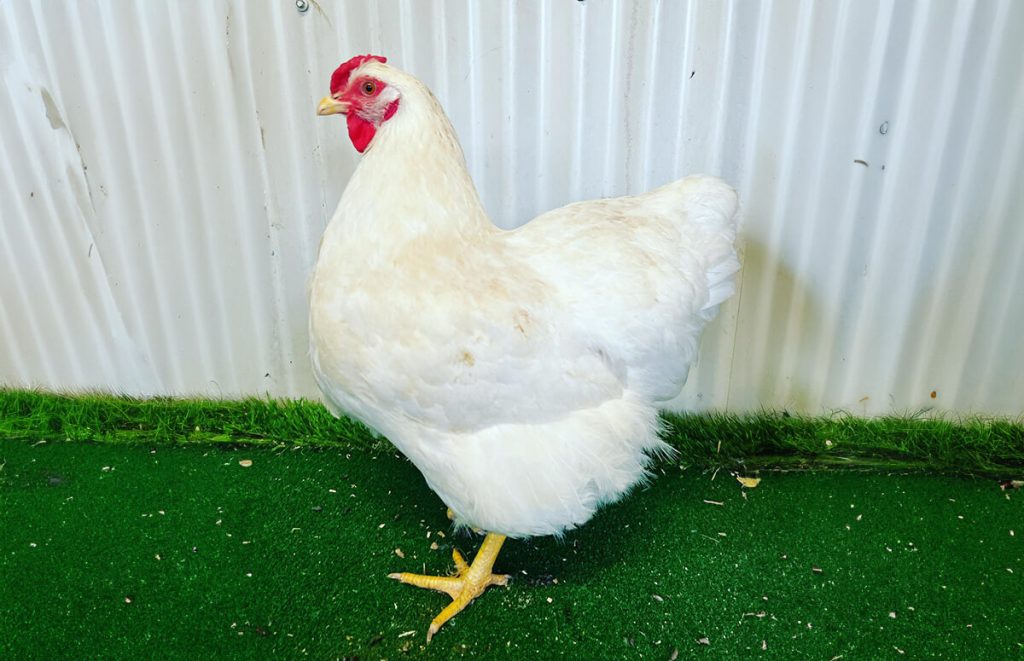
White Wyandottes have a red rose comb, and their legs are clean and yellow. The wattles and earlobes are red. Their beaks are dark golden, complemented by yellow eyes.
Eggs
White Wyandotte hens are great egg layers, bringing around 200 medium to large brown eggs yearly. In the winter, they usually slow down or stop laying, but if you add extra light, these cold-hardy birds tend to keep laying eggs.
The only time Wyandottes stop laying eggs is during molting, which happens each year around late summer or early fall.
They are dual-purpose birds, appreciated for both their meat and egg-laying capabilities.
These chickens are also likely to go broody occasionally, which is great news if you plan to hatch eggs. But keep in mind that egg production will temporarily stop during broodiness.
Pros and Cons
Many chicken keepers love the White Wyandotte breed. Let’s explore the primary reasons for and against going for a Wyandotte chicken.
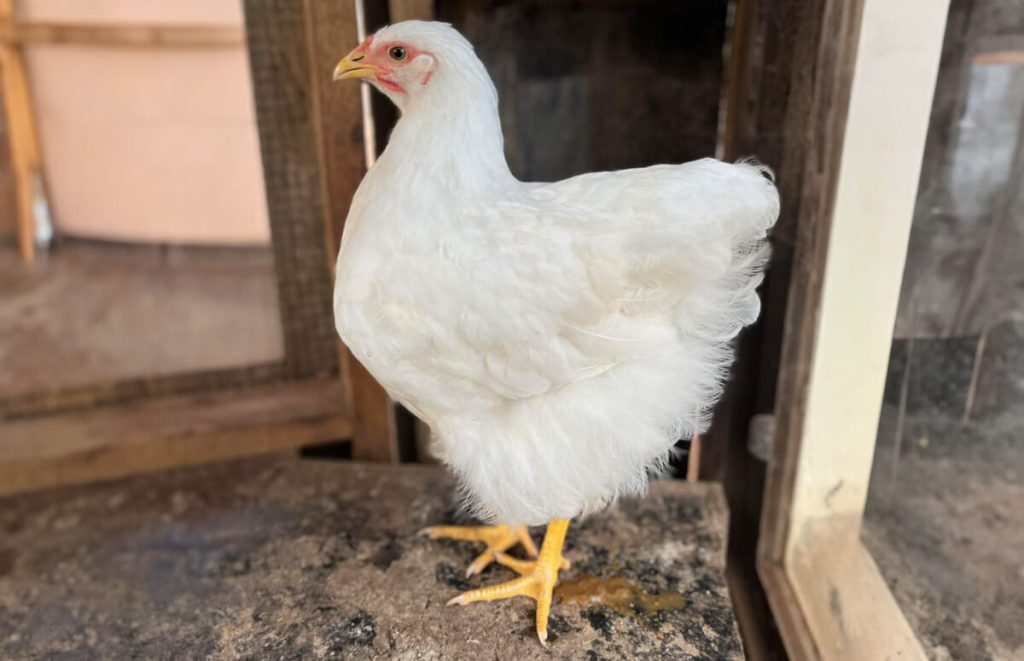
On the positive side, these chickens do great in cold climates. Their small rose combs and fluffy bodies make them remarkably resilient to chilly temperatures. Additionally, their unique snow-white plumage adds an amazing touch to any flock. This dual-purpose breed, known for both egg production and meat quality, makes them a wanted breed with many homesteaders living self-sufficient lives. Wyandottes are also excellent foragers, reducing the need for extra feeding.
| Pros – Reasons to choose for Wyandottes | Cons – Reasons to go for another breed |
|---|---|
| Cold-hardy Excellent foragers Dual purpose breed Beautiful color Don’t need much extra care Friendly towards people | Need more space Dominant towards smaller breeds Don’t do well in warm climates Some breeds lay more eggs They are no lap chickens Tend to go broody |
However, this also means they need more space than most other breeds. Next to that, despite their cold-hardy nature, they do not fare well in warmer climates. Additionally, Golden Laced Wyandottes are a dominant breed, which can result in conflicts if you keep a mixed flock. It’s best not to keep them together with submissive breeds like Silkies or Faverolles.
White Wyandotte Hen vs White Wyandotte Rooster
Both White Wyandotte hens and roosters have beautiful snow-white plumage with no other colors present. They can look very similar, with white feathering, red earlobes and wattles, and round body shape. It can be challenging to distinguish roosters and hens.
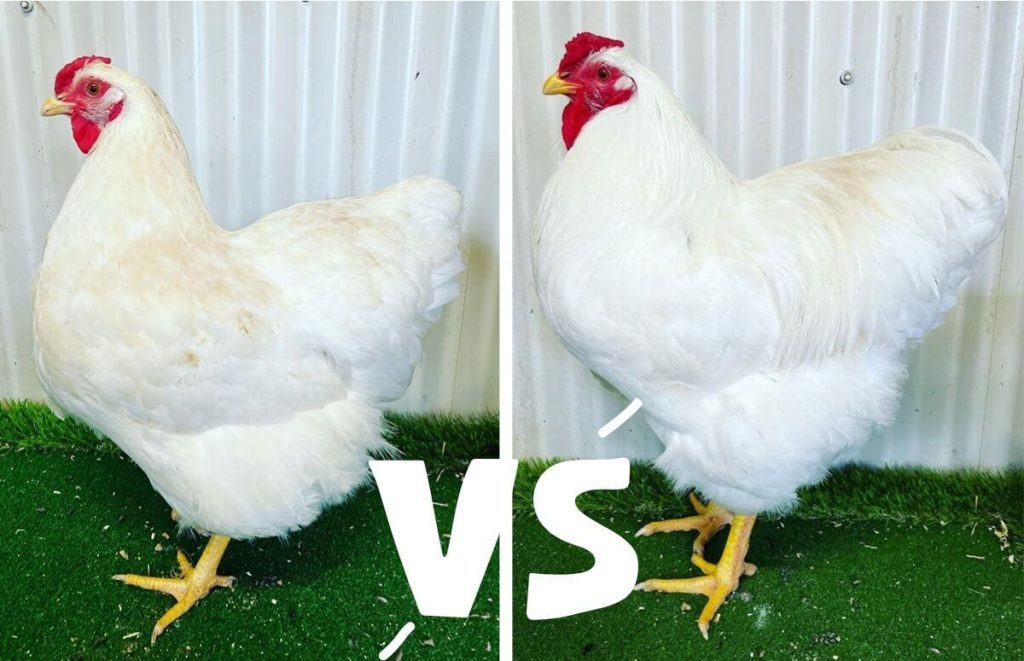
However, roosters are larger and more robust, with white sickle feathers and hackles. Overall, roosters tend to be larger and heavier than hens. While hens typically weigh around 6-7 pounds, roosters can reach 8-9 pounds.
Both Wyandotte hens and roosters have the characteristic rose comb that is compact and close to the head. However, the comb tends to be slightly larger and more pronounced in roosters.
| Feature | White Rooster | White Hen |
|---|---|---|
| Weight | 8 lbs | 6.5 lbs |
| Back | Pointed saddle feathers | Rounded feathers |
| Plumage | White | White |
| Tail Feathers | Long sickles, pointed | Shorter, rounded on the edges |
| Comb, Wattles | Big, red | Small, pink |
| Body | Large and broad with long legs | Smaller, shorter legs |
Chicks
White Wyandotte chicks have no patterns in their down. They look exactly like you imagine chicks would look. All white Wyandotte chicks are yellow-colored right after hatching and remain yellow until their down changes to regular feathers.
The photo below shows a mix of all kinds of Wyandotte chicks. As you can see, the laced Wyandotte chicks all have dark patches in their down.
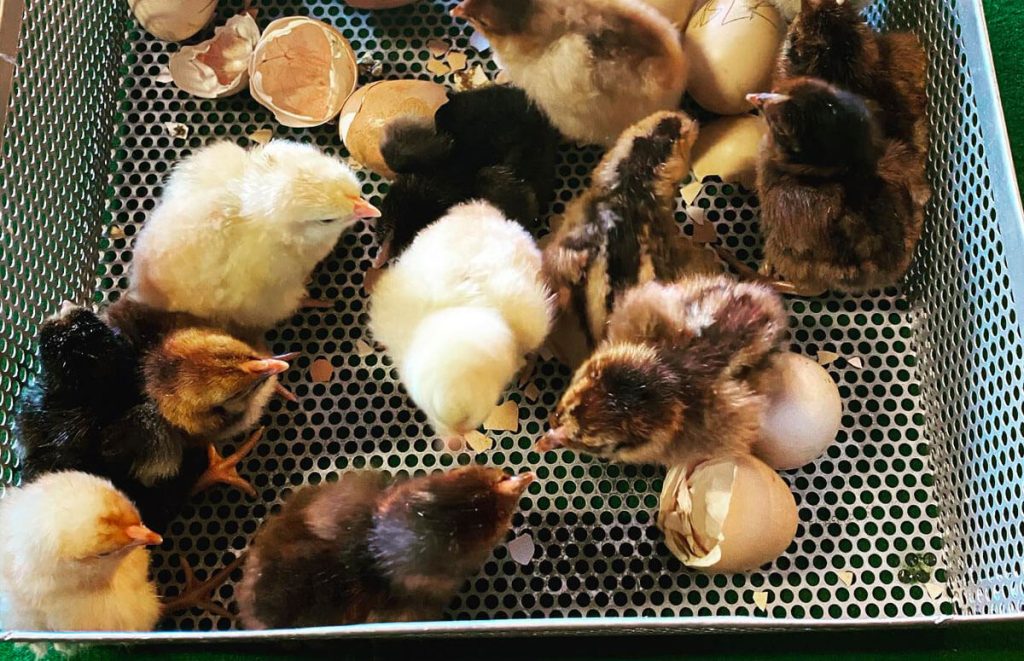
When they hatch, you can immediately see the yellow shanks and beaks.
White Wyandotte chicks are not sex-linked, so you can’t initially tell whether they are female or male. Identifying the gender takes a couple of months. When they grow up, cockerels are generally larger, with saddle feathers and long sickles. After five months, you should be able to distinguish the roosters and hens.
Care
Caring for White Wyandotte chickens is relatively easy. They require the same basic care as other chicken breeds, including a well-ventilated coop, access to fresh water and balanced feed, and protection from predators and the elements.
Additionally, providing them with a clean environment will help maintain their pure white plumage.
Climate
Wyandottes are very cold-hardy, having been bred to survive cold American winters. Their small rose combs and plump bodies enable them to endure freezing conditions and prevent frostbite.
But just because they are white does not mean they are polar bears, either. Their combs and wattles are still susceptible to frostbite in extremely cold weather. Therefore, always keep a close eye on your flock during extreme weather.
While they can bear cold temps, White Wyandottes do not like warm temperatures. They are not the best breed to keep when you are living in a warm or tropical climate. They can quickly overheat and suffer from heat stress.
Better breeds to keep in warm climates are Mediterranean breeds, such as the Ancona chicken or the Andalusian. They have larger combs that can release the heat.
White Wyandotte Color Variety
White is not the most popular color in Wyandotte chickens; that honor is reserved for the laced and penciled varieties.
The Standard of the American Poultry Association recognizes only ten official Wyandotte color varieties, while the Europeans list thirty colors. Let’s see how the White variety stacks up against the other variations.
In general, Wyandottes come in three groups:
- Laced Wyandottes: silver laced, gold laced, blue laced, …
- Marked Wyandottes: black-white Columbia, Silver Penciled, …
- Single-colored Wyandottes: white, blue, black, buff, …
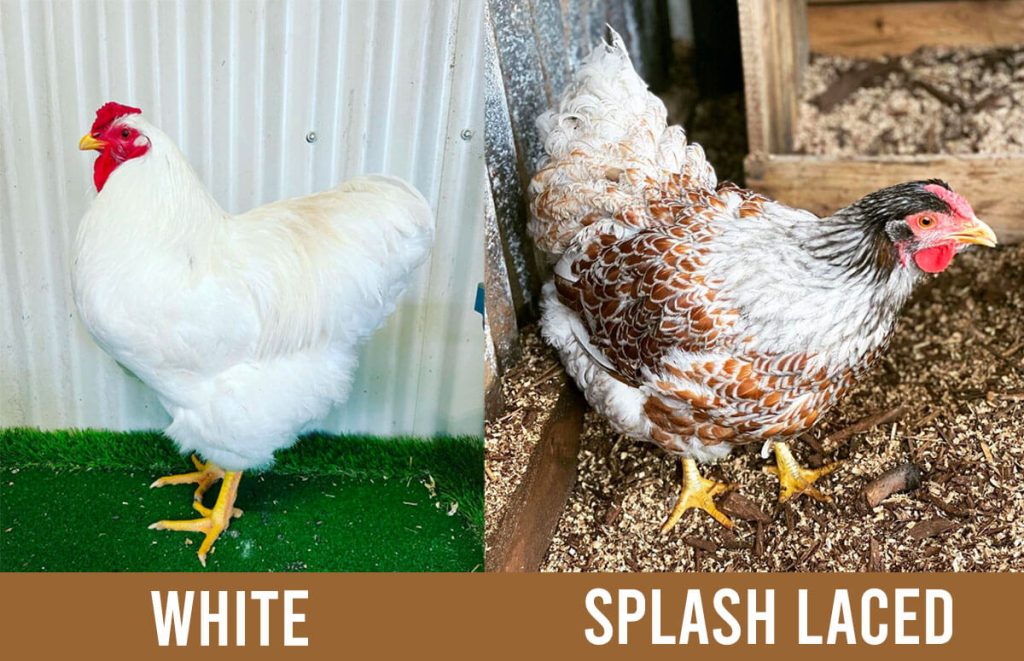
The first variety of the Wyandotte family was the Silver Laced Wyandotte. All other color varieties, including the White Wyandotte, were derived from the Silver Laced Wyandotte.
In the case of the White Wyandotte, it was a “sport” that appeared as a genetic mutation in the breeding of Silver Laced Wyandottes, which led to the creation of a new variety with white plumage. White Wyandottes were standardized on the same date as the Golden Laced, in 1888.
History of the White Wyandotte
The Wyandotte breed, from which the White Wyandotte derives, has an exciting and somewhat complicated lineage. Four breeders, H. M. Doubleday, John Ray, L. Whittaker, and Fred Houdlette, developed the White Wyandotte in the US in the late 19th century.
The Silver Laced Wyandotte is considered the original variety and played a key role in shaping the breed. The exact origins of the Silver Laced Wyandotte are uncertain, with speculation about including breeds like the Dark Brahma and Spangled Hamburg.
The White Wyandotte chicken, however, was not a primary or initial variety of the Wyandotte breed. Instead, it originated as a “sport” from the Silver Laced Wyandotte. In chicken breeding, a “sport” refers to a sudden genetic mutation that results in unique traits or plumage changes. [J.P Quin]
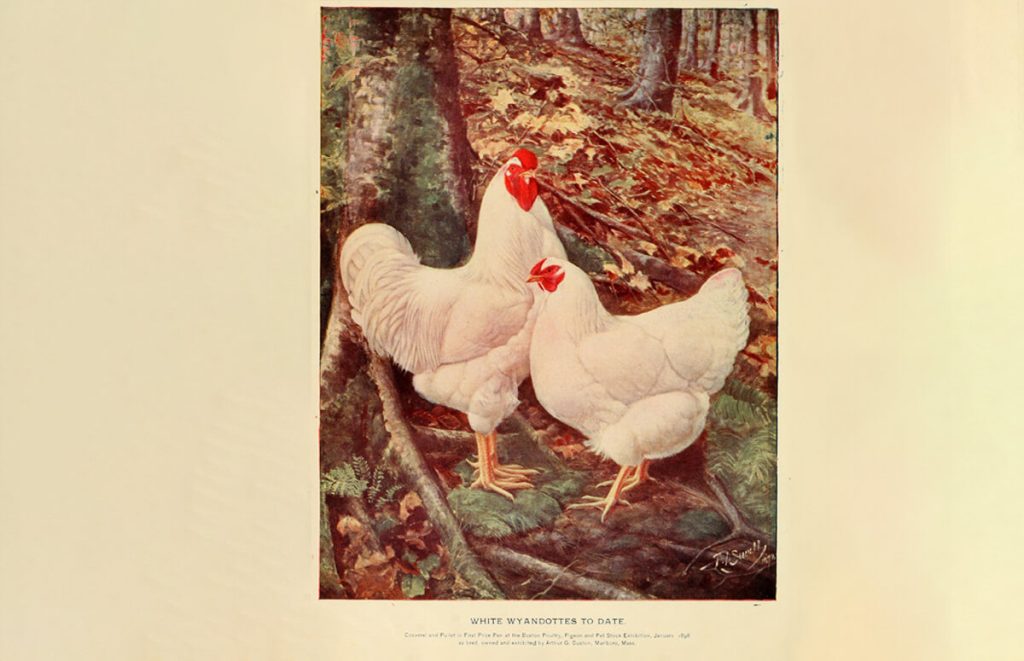
In the case of the White Wyandotte, this sport displayed an all-white plumage, a remarkable genetic variation that captured the attention of breeders.
The original White Wyandottes did not have the shape and colors of today’s showbirds. They resembled big rose-combed Leghorns with dirty white feathers and occasional black specks. This vintage photograph, taken from a 1902 Illinois poultry magazine, offers a glimpse into the appearance of the White Wyandotte back in 1894:
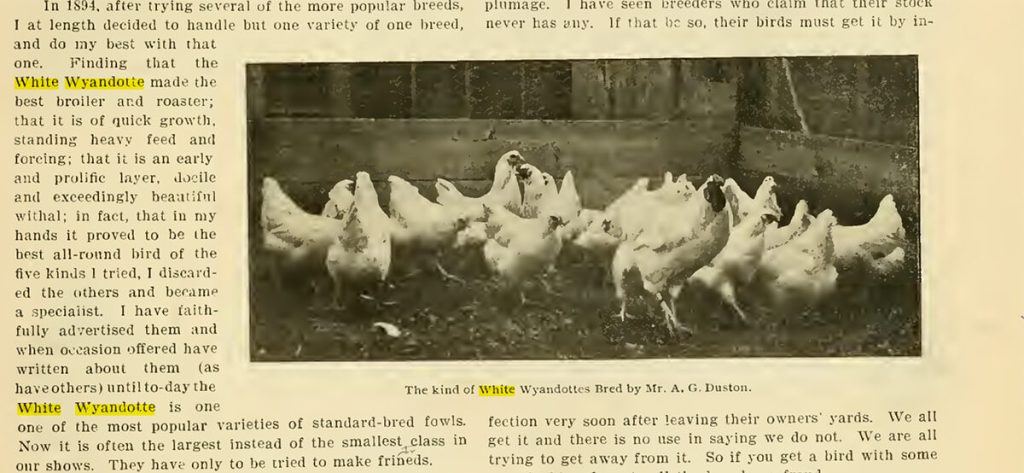
White Wyandottes were standardized by the APA in 1888.
American Wonder Fowl
There have also been some sidelines of the White Wyandotte. One example is the extinct American Wonder Fowl in 1899. At that time, they mated Silver Wyandottes with little markings with white Cochins to create White Wyandottes. Except for their feathered feet, these birds were nearly identical to the White Wyandottes. However, most breeders did not like these birds’ foot feathers*.
* Sources: Unser Hausgefliigel, Pfennigstorff 1903, Taschenbuch der Rassegefliigelzucht, Rudolf Kramer 1899, via Sigrid van Dort
Genetics
White Wyandottes are white because they lack any black or red pigments. These pigments are suppressed by the recessive white genes, also known as colorless c or cc. This genetic mutation originally diverged the White Wyandotte from its parent variety, the Silver Wyandotte.
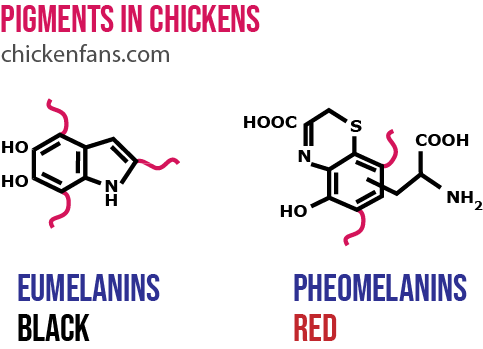
However, already in 1916, the history books described the presence of a Dominant White (Inhibitor I) gene. This gene primarily inhibits the black pigment eumelanin. This probably resulted from crossbreeding the White Wyandotte with the White Leghorn to improve its egg-laying abilities.
Depending on the origin, some White Wyandottes also carried genes for baring and black. If you mate these White Wyandotte hens with non-Silver males, you will produce silver-barred roosters and black-gold hens.
Breeding
If you are breeding White Wyandottes, you must account for the presence of recessive white (cc) and dominant white (I) in the gene pool.
One of the biggest challenges in breeding White Wyandottes is suppressing a yellow hue or dull deposit and entirely or partially discolored feathers. Dominant white mainly inhibits the black color and not the red pigments. Recessive white inhibits both color pigments, but it can leak red pigments into the feathers.
The photo below shows this pretty well. It’s a breeding flock, but several birds have some yellow leaking.
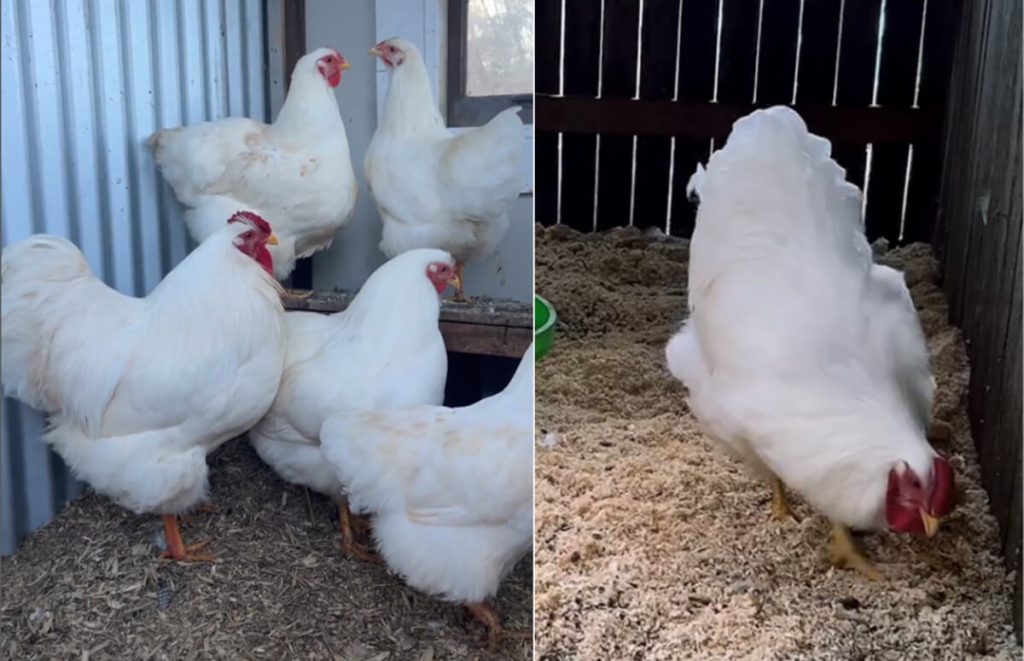
If you start crossing out with Laced Wyandotte birds, you get all kinds of results, but whenever two c-genes align, you get a white bird again. If you are dealing with dominant white on top of cc, you will get many white birds, as this gene doesn’t hide.
Personality
White Wyandottes are known for their pleasant personalities. They are friendly towards humans and children. Their adaptability, social nature, and calm disposition make them an excellent choice for newbies and experienced chicken keepers.
White Wyandottes can display dominant behavior towards other chicken breeds. While generally calm and friendly, they may assert themselves when interacting with submissive or bantam breeds. This behavior often helps to maintain the pecking order within the flock but should be monitored to ensure that all chickens coexist harmoniously.
Other Reads
Here are some of the articles we mentioned:
- Wyandotte Chickens: an overview of the Wyandotte chicken breed and the color varieties
- Silver Laced Wyandotte: a breed profile of the Silver Wyandotte variety
- Silver Penciled Wyandotte: a breed profile of the Silver Penciled Wyandotte variety
- Golden Laced Wyandotte: a breed profile of the Golden Laced Wyandotte variety
- Buff Wyandotte: a complete guide of the Buff Wyandotte chicken and buff varieties
- Blue Wyandotte: a complete guide of the Blue Wyandotte chicken and blue varieties
- Splash Laced Red Wyandotte: a guide on the Splash Laced Red variety
- Columbian Wyandotte: a striking black and white variety of the Wyandotte chicken
- Sebright Chickens: a chicken breed that has varieties with a similar lacing pattern
- Brahma Chickens: large chicken breed initially used to create the Wyandotte
- Hamburg Chickens: chicken breed used to create the Wyandotte, with similar black and white patterns
- Chicken Feather Guide: to understand the difference between all types of feathers
- Chicken Breeding & Genetics: an overview for chicken breeding and genetics for beginners
If you are considering to get Silver Laced Wyandottes, here are some other resources:
- Chicken Coop Size Calculator: to calculate the size of your coop
- Chicken Raising Guide: general chicken raising guide
Credits for the photos and special thanks go to Cactus Hill Poultry breeders, specializing in breeding Wyandottes.






















